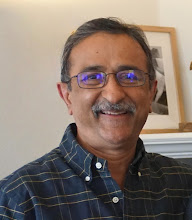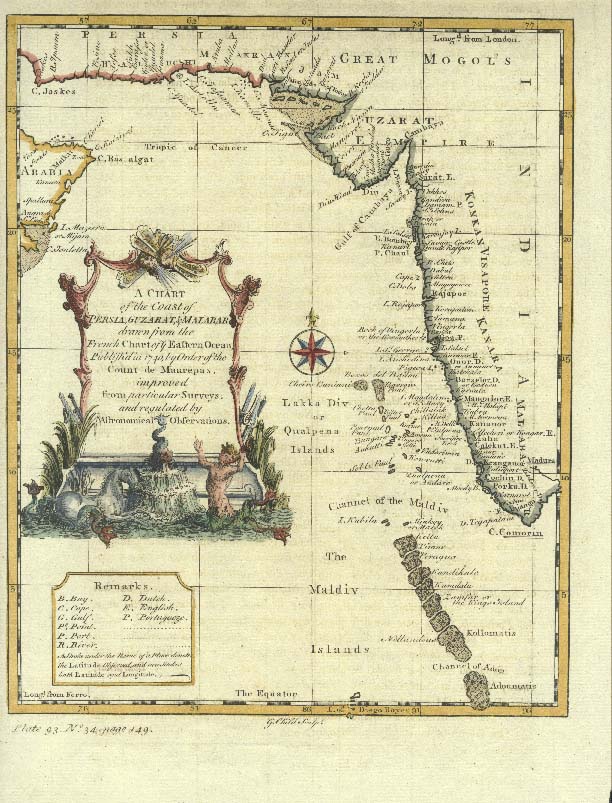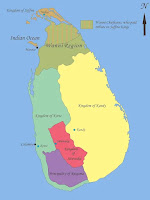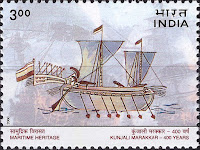Marakkars, Paravas, Portuguese, and the Zamorin…
It was, in retrospect, a decisive battle and one that signaled some amount of success for the Portuguese. Suppose the Marakkars had continued, reached Diu, and eventually joined up with the incoming Ottoman fleet. In that case, the Portuguese might have been taken out of the equation just 40 years after they arrived in Western India. But as we saw in a previous article, the Marakkars never reached Diu, and the Turkish Captain Hadim Suleiman slunk away with his fleet. I had promised to get to this part of the story, so here goes.
The battle of Vedalai, near Mandapam, which occurred in 1538
between Malabar’s Marakkar admirals and the Portuguese fleet, was of incredible
importance. Not only did it wrest away the control of those waters from the
Marakkars after Pate’s loss, but it also gave the Portuguese full control of
the gulf as well as the pearl fisheries in the area. It broke the Marakkar
naval might, as well as their plan to team up with the Ottoman fleet and
threaten the Portuguese. With this singular event, the supremacy on the Arabian
Sea passed to the Portuguese, who then settled down to profit even further from
their overtures.
While almost all previous articles and studies have focused solely on the trio of the Zamorin, the Portuguese, and Mayadunne, the ruler of Sittawake, it is essential to note that there were two additional dimensions: the Paravas of Kayalpatanam and the Ottomans.
The Paravas vs Markkaras
Before we get to the battle itself, let us get a feel for
the background and the situation down south, well before the arrival of Francis
Xavier. It was a period when the Paravars were feuding with the Marakkars
living in the region, while conducting a lucrative pearl business, from the
various small ports between Kayal Pattanam and Vedalai (Vedhalai) near
Rameswaram.
The advent of the Portuguese to the area is connected to the
conversion of the Parava fishermen in the region, catalyzed by a one-time
Zamorin emissary who converted, i.e., João da Cruz, in 1534-36, an event I
had covered in the past. The Parava community extended from the Cape, all
the way to Kilkarai in the NE, passing through the region which we are covering
today. Preceding the many decades before this conversion, and for many decades
thereafter, the local Muslims (Labbais, Rawthers, and Marakkars) and the
Paravas were at loggerheads with each other, resulting in frequent skirmishes.
After the conversions (around 20,000) and protection obtained from the
Portuguese, armed intervention by the navally stronger Portuguese kept the
Paravas relatively safe.
The Zamorin’s connections to the area were mainly through
the Marakkars and their trading interests in the region. The Marakkar traders
were very much involved with and potentially controlled the cinnamon trade (through
historic Chaliya links to Calicut), the coir trade of Maldives the elephant
trade of Ceylon. Using family networks, the Marakkar merchants used to bring
either by sea or later (due to the strict imposition of cartazs) through land
links, rice, textiles, and other goods from the various ports of Coromandel
like Kunimedu, Kilakarai, and Kayalpatanam to Cochin and Malabar. They brought
cinnamon from Ceylon, cloves, mace, and other commodities from Malacca and
other parts of South East Asian countries before the Portuguese occupation of
Malacca. Furthermore, the royal monopoly over the spice trade in Malacca and
the Moluccas expired in 1533. The Marakkars were also rivals to the Paravas
when it came to pearl fishing, and ended up fighting with the Paravas over
rights. This snowballed into massive confrontations and conversions, with the
Portuguese taking advantage of the situation.
Zainuddin, the Ponnani scholar, in his Tuhfat-ul Mujahidin
states that the Marakkars had turned against the Portuguese by about 1524,
perhaps as early as 1522. He states - In the same year, some of the faquis
in Kashi [Cochi] like Ahmed Marakkar, his brother Kunj Ali Marakkar, their
uncle Muhammed Ali Marakkar, and other dependents felt the desire to wage war
against the Portuguese. They left Kashi [Cochin] for Kalikut.
The Portuguese started to control the straits, channels, and
the seas, much to the consternation of the Marakkars, and we read about their
involvement and tie-up with Vitthala. As time went by, the Marakkars and the
Kotte Tamils teamed up with the Zamorin and the Ottomans, the Paravas with the
Portuguese.
The scene at Ceylon
The threat from the Portuguese (who had landed on the island
in 1505) increased in 1518 when they attempted to build a fort at the ‘hook of
Colombo’ named ‘Our Lady of Victories’ by some and ‘Santa Barbara’ by others,
permitted to do so by the Kotte King. The Zamorin sent a force the same year under
the command of Pachi Marakkar (or was it more correctly Pattu?), only to be repulsed
by the Portuguese. Pachi returned to Calicut after promising Vijayabahu that he
would be back with reinforcements. The Portuguese, anticipating this, by deploying
Cochin forces to Colombo, met Pachi Marakkar’s fleet at sea and in the battle
which ensued, destroyed three of his ships.
During this interim, the Marakkars were busy in the Gulf of Mannar
and in their efforts to take over the pearl fishery, had many encounters with
the Paravas. Many Portuguese ships sailing in from Malacca were looted, João
Flores was killed, and Manuel da Gama was chased away. In 1524, the Portuguese
dismantled their Kotte fort. The Zamorin’s decision to support Mayadunne and
the decision of the Marakkars to get involved with Lankan politics were with an
intent to wrest back the control of trade in the region, stop interference by
the Paravas, and keep the Portuguese away from the Malabar coast.
Mayadunne did not give up and again exhorted the Zamorin for
more support, offering to pay all expenses. In 1536, the Zamorin sent an even
bigger force, commanded by Ali Ibrahim from Pudupattanam, and combining with
Mayadunne’s forces, besieged Kotte. As before, when they heard that Martin
Affonso had set out from Cochin, the Calicut forces decided to avoid
confrontation with the Portuguese and withdrew from Kotte. However, Ali
Ibrahim’s retreat did not go well, and in a bitter encounter, much of his fleet
was destroyed. It was also around this juncture that the Paravas in the mainland
had fully aligned with the Portuguese against the Marakkars.
Mayadunne continued to pressure the Zamorin, and this time
the Zamorin sent out an even larger fleet with all his admirals, Pachi Marakkar,
Kunjali Marakkar, and Ali Ibrahim. 57 ships and 8,000 men, many armed with
armor-piercing arquebusiers, from Ponnani in Dec 1537.
Vedalai - Marakarpatinam
Pachi and Kunjali then disembarked at Vedalai and moved
their forces inland. Vedalai, a fishing village in Ramanathapuram, is at the
tip of the Indian landmass, just before the Pamban bridge and neighbors
Marakkarpattinam. Starting with an attack on the pearl fishery coast, they
decimated the villages around Tuticorin, disembarked to wait at Vedalai,
between Kilkarai and Rameswaram, near Pamban (today that is Marakkar Patinam). It
is at this point that we get to know that the Zamorin and the Marakkars had
already established contacts with the Ottomans, for Pate Marakkar boasted that
he would carry on a war with Ceylon and the Portuguese, till the Rumes (Turks)
arrived at Diu (an event which would take place only 4 years after) and the
fleet of the Turks, Marakkars and the ruler of Cambay would unite. He also
added his hope that the Ottoman ruler would thus become India’s ruler.
In the wars between the Marakkars and the Portuguese in the
waters around Ceylon, the Portuguese lost close to 50 ships. The town of Kayalpatinam
was burnt by the Paravas. Nevertheless, Martim Affonso de Sousa had reason to never
forget his victory at Vedalai and his Paravas. During the battle, he had withstood
a rain of bullets and had been struck by a musket ball. As a scribe wrote - At
the time of every new moon, a crippling pain reminded him of it. The
relation between Mayadunne and the Zamorin was severed after the event, and the
Marakkar fleet had to be reconstructed at Calicut, as the new Zamorin had no choice
but to sue for peace with the Portuguese.
Mayadunne continued his fight to try and establish himself
as the Lankan emperor, especially since the Buddhist monks had brought over the
Tooth Relic of Buddha, and placed it under the protection of Mayadunne, seeing
that the Portuguese were hostile towards Buddhism. Mayadunne and his son
Rajasinha were able to hold the Portuguese at bay on land for most of the 16th
century, though defenseless against Portuguese sea power. Rajasinha and his successors
continued the wars after Mayadunne passed on in 1581.
Ottoman forays
As
explained in more detail in my article - The Ottomans, who occupied Egypt
in 1516/7 displacing Mamluks and their commercial allies, the Karimi, began to
increasingly depend upon Marakkar traders for obtaining spices, but it was not
easy with the Portuguese ships prowling the Arabian seas. In the Persian Gulf region,
the Ottomans captured Baghdad in 1534 from the Safavids, and a naval base was
established near Basra in 1538. Meanwhile,
the old hand Hadim Suleyman was still waiting for his fleet after Mustafa
Bayram had defected to join the Mughal king Humayun. But before that, Bayram
did establish a formal link with Calicut and made a tie-up with the Marakkars
in their ongoing attacks against Portuguese shipping. With Bayram’s defection,
the Diu chief conceded to Portuguese authority, albeit temporarily, as his
confidant Khoja Safar got in touch with the Ottomans for support. Hadim
Suleiman, then in Romelia, was reassigned quickly to Egypt and asked to prepare
for a naval mission to Diu and Malabar.
As Casale explains - the most probable scenario seems to be
that Hadim Suleiman, encouraged by envoys sent from Pate Marakkar and the
Zamorin of Calicut sometime in 1537, dispatched Hamad Khan to Aceh at the same
time as his departure for India, with orders to harass Portuguese ships and, if
possible, assist in an attack on the Portuguese fortress of Malacca. By 1538,
the pasha had managed to construct an enormous transoceanic coalition, linking
Istanbul with allies across the entire breadth of the Indian Ocean from Shihr
and Gujarat to Calicut and Sumatra. Pate Marakkar and his fleet had been taken
on by the Portuguese at Vedalai off the Ceylon straits, even before they could
sail North to support Hadim Pasha, and were defeated. Additionally, the Acehese
attack on Malacca was repulsed by the Portuguese. As we can see, the battle of Vedali
destroyed the possibility of the Marakkars teaming up with them, for they had
been decimated in February 1538, and the Zamorin was despondent.
Nevertheless, the Ottoman expedition of 1538 followed, with
the 70-armed vessels that laid a siege on Diu. But as it all transpired, after intense
bombing by the Turkish forces for all of 40 days, that too, just as the
Portuguese were about to cave in, Hadim Suleiman decided to call off the siege
and retreat to Yemen. Was it because he feared decimation by a rumored incoming
Portuguese fleet from Goa, already on the prowl since there was no Marakkar
fleet to stop them? Perhaps so, nevertheless, the old admiral feared the
possibility of ignominious defeat, and possibly revolt, as he turned out to be
a looter, not a savior to the people of Diu. Also, it turned out that when his
ships reached Diu, four of them had capsized to reveal a large number of
saddles, proving that the Ottomans indeed had plans to occupy lands, settle
down, and not just liberate Diu. The Diu Emir Bahadur chose to quickly side
with the Portuguese, seeing that the Ottomans could be far more avaricious and
cruel compared to the former.The Ottoman ships now went back and entrenched
themselves firmly in Yemen, with all Indian intentions forgotten. Hadim
Suleiman was rewarded and installed as grand Vizier in Istanbul at the age of
90, while Aden was retaken in 1551 by Piri Reis.
The Zamorin was so cast down by this disaster that he sent
China Cutiale as his ambassador to Goa and made peace with the Portuguese, as
the Marakkars nursed their hatred for accursed Franks and bided their time for
revenge. A treaty was thus concluded in
January 1540, beneficial to the Portuguese, one that lasted 36 years. It had a
terrible effect, for it may have diluted the relations between the Marakkars
and the Zamorins as some of the seamen moved from Ponnani to Kottakkal to
settle under the Raja of Kadathanad, the ex-Porlathiri ruler, and continued as
corsairs. Not long after, St Xavier arrived in 1542 and was further involved in
instructing the thousands of Parava fishermen who had been converted to Roman
Catholicism around 1535, but whose religious knowledge remained minimal.
Pamban Canal
Following this, the Portuguese built fortifications and took
control of the pearl fisheries in the southern and Coromandel coast,
strengthened their grip on the Coromandel coast, the pearl industry, salt pans,
as well as Ceylon trade, and remained as the muscle for the Parava community in
the region. It was the Portuguese chieftain Correia who cut the Pamban trench
to exact tolls from pilgrims to Rameswaram and make a nuisance of himself,
a story we covered earlier. Many Tamil Marakkars
continued to trade and sail in South India, (perhaps even sailing as far away
as New Zealand in later days), entrenched in their town of Marakarpatinam and
kept disrupting Portuguese designs.
Who was the interesting captain who came up with the idea of
tactfully burning the Marakkar ships in 1538?? Nicknamed ‘O Malabar’, he was a
Christian Nayar (mixed parentage or a convert) from Cochin, who showed great
valor in many Portuguese battles. More on him later.
Now for some trivia…And, many centuries later, close to this
very same town of the Marakkars was born the great scientist Avul Pakir
Jenulabudhin Abdul Kalam, a Marakkar who went on to become the President of
India, ….
References
South India and Sri Lanka 145-1650 AD, Political, Commercial
and Cultural relations (Journal of Tamil Studies 1982) - S Patmanathan
The Temporal and Spiritual Conquest of Ceylon- Fernao De
Queyroz
Jesuits in Malabar Vol 1- Ferroli D
Francis Xavier: his life, his times. Schurhammer, Georg (Tr
M. Joseph Costelloe)
The Ottoman age of exploration – Ginacarlo casale











0 comments:
Post a Comment